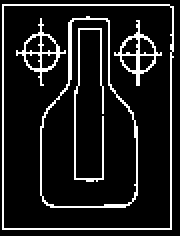 Available from Speedwell Target.
Available from Speedwell Target.
U.S. IPSC Target Suppliers
Alco Target
2048 Central Avenue
Duarte, CA 91010
818-358-4814 (voice)
818-301-9084 (FAX)Speedwell Target
136 Lincoln Boulevard
Middlesex, NJ 08846
908-560-7171 (voice)
908-560-7475 (FAX)
speed6050@aol.comDave Zimmerman
Target Barn
P.O. Box 352454
Toledo, OH 43635-2454
1-800-378-7675 x0175
FBI QIT Target
 Available from Speedwell Target.
Available from Speedwell Target.
136 Lincoln Boulevard
Middlesex, NJ 08846
908-560-7171 (voice)
908-560-7475 (FAX)
speed6050@aol.com
Federal Air Marshal Handgun Qualification Course.
Poor Man's Target Frame
Welded target frames typically cost $25 or more. You can cut cost by
building your own. They won't be as compact as welded frames might,
but they will be functional.
Need:
Procedure:
Poor Man's Reactive Targets
There are plenty of things people shoot at that fall, explode,
swing, etc. when hit, but a good poor man's training tool has at least
one of two qualities:
PLEASE: don't shoot glass bottles or
pressurized containers, and whatever you shoot, clean up after
yourself. Public lands are constantly being closed to recreational
firearms use because of the garbage shooters leave lying around after
punching holes in it. Please help preserve our right to to use public
lands, and, as best as you can, leave no trace.
Poor man's reactive target array:
This system is portable, reusable, and relatively inexpensive. The
4x4 pieces will have to be replaced after 80 or so shots, depending on
the wood, the caliber, and your load. 11-inch lengths will fit well
into a milk crate for transportation.
In the long run, steel targets may be more economical, though not as
portable. I'd be interested in hearing from anyone who has built
a pepper popper or other steel targets on a poor man's budget.
Wax bullets
Measuring Groups
There are all kinds of
ways to measure groups, but the most common (because it's the
simplest) is the center-to-center median (CTC). This is not an
average, it is simply a measurement of the distance between the two
most widely placed shots on the paper.
It's usually obvious which two shots are farthest apart, but if it's
not, a set of calipers can come in very handy. Set them at the
outside edges of two shots, and then see if the distance between any
two shots is larger.
Once you have an accurate measure from the outside edges of the widest
shots, to get the center-to-center distance, subtract the diameter of
the caliber. So if the edge-to-edge distance of a .40 caliber is 1.15
inches, CTC is 1.15 minus .40, which is .75 inches.
The drawback to the CTC median is that flyers penalize you more
than they really should. This measurement of distance is most useful
if your groups are relatively small to begin with, which for most of
us means slow-fire at distances under 50 yards. An averaging
technique is a more useful measurement for any rapid-fire group, or
for a shooter who tends to put a few rounds out of a nice group.
Most averaging techniques require a computer or are labor
intensive, but if you know in advance that you want to average a
group, a simple solution is to shoot on an NRA bullseye target. At
sanctioned distances, the slow-fire targets are calibrated closely
enough to be a good averaging estimate--just fire 10 shots and tally
the score.
The drawback to NRA targets is that they measure deviation from target
center, not group center. Calculating a true average from group
center is an involved effort, and beyond the scope of this page.
If you have a postscript printer, NRA targets are available here.
Orange County Shooting /
First Aid /
Email Dan Young
Go to index page /
Go to Dan Young's Home Page
One 8' 2x4
Two 5' 1x2s
Two short (6") 1x2 spacers.
Saw (and miter box if you are using a hand saw)
C-clamps capable of a 4" span
drill and screws, or hammer and nails
clamp clamp
XXXXXXXXXXXXXXXXXXXXXXXXXXXX
SS SS
XXXXXXXXXXXXXXXXXXXXXXXXXXXX
clamp clamp
X X
X X
X X
X X
X X
X X
X X
X X
--> XXXXXXXXXXXXXXXXXXXXXXXXXXXXXX <--
X SS SS X
--> XXXXXXXXXXXXXXXXXXXXXXXXXXXXXX <--
X X
X X
X X
X X
X X
X X
X X
X X
One pair detachable sawhorse brackets
Procedure:
Two eight-foot 2x4s
One eight-foot 1x6
Enough 4x4 post to get at least six 11-inch lengths
 This section is under development.
This section is under development.